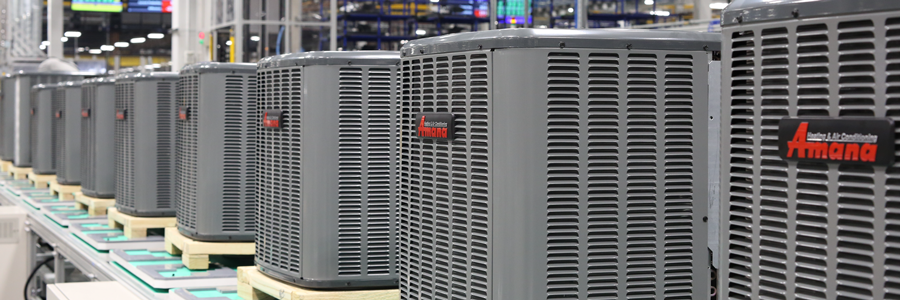
The differences between an air conditioner and heat pump can be a hot topic – or cool depending on which way you look at it! From the outside, the two pieces of HVAC equipment may appear nearly identical. Yet, one of them is designed to move heat indoors or outdoors depending on your indoor thermostat or control system settings.
The Cool Similarities
Air conditioners and heat pumps, the outside portion of a split HVAC system, are designed to cool indoor spaces. Each relies on the “closed-loop” refrigeration cycle principle. This means that the same refrigerant is continuously circulated, passing through the air conditioner or heat pump and the indoor evaporator coil.
In cooling mode, induced pressure changes from the condenser coil, compressor, evaporator coil and the expansion valve force the state of the refrigerant is to fluctuate between a liquid and gas – moving the heat from your home to the outside.
Air conditioners and heat pumps keep your home cool in the same manner.1
- The warm air from inside your house is pulled into ductwork by a motorized fan. To cool your home, the heat is pulled out of that air.
- The air is cooled by blowing it over a set of pipes called an evaporator coil. As the refrigerant flows through the indoor evaporator coil, the refrigerant changes from a liquid to a gas as it absorbs heat from the air.
- The cooled air is then pushed through connecting ducts to vents throughout the home, lowering the interior temperature because air with less humidity seems cooler than air that contains a high level of humidity.
- The refrigerant is pumped through a closed system to an outdoor coil in the air conditioner or heat pump, where it gives up its heat and changes back into a liquid. This outside coil is called the condenser because the refrigerant is condensing from a gas back to a fluid just like moisture on a cold window.
- A pump, called a compressor, is used to move the refrigerant between the two coils and to change the pressure of the refrigerant.
- When the indoor temperature reaches the set point on your thermostat or control system, the air conditioner or heat pump pauses until your indoor air gets too hot.
- The refrigeration cycle continues as needed for your indoor comfort, year after year, providing a consistent method to keep you cool.
When comparing an air conditioner to a heat pump, be sure that you compare the various features, SEER (Seasonal Energy Efficiency Ratio) value, and the size or tonnage. The performance of the heat pump and air conditioner will only be identical if all of the efficiency aspects are identical, as well.
The Reversing Valve Difference
The heat pump and the air conditioner may rely on the same fundamental refrigeration principle, but there is still one key difference. If your home needs a heat source, a heat pump system can pull double duty — cooling and heating your home for year-round comfort.
Unlike an air conditioner, a heat pump is designed with a reversing valve that automatically changes the direction of the refrigerant flow when heat is needed in your home. When the reversing valve flips to heating mode, the refrigerant in the outdoor coil becomes cold enough to absorb heat from the outside air. This is opposite from the cooling mode where the cold indoor coil removes heat from the indoor air.
When the refrigeration cycle in a heat pump is reversed, it results in warm air being distributed to your home!
Here’s how it works:
- The reversing valve changes the direction of the refrigeration cycle. This causes the outside coil to function as the evaporator and the indoor coil to function as the condenser.
- As the refrigerant flows through the outdoor coil, the refrigerant changes from a gas to a liquid as it absorbs heat from the outside air.
- Although outside temperatures are cold, enough outdoor heat energy is absorbed by the chilled external coil and released inside by the warm indoor coil in the air handler.
- Cool air from the inside of your house is pulled into ductwork by a motorized fan in the air handler.
- Once the heat energy is transferred from the indoor coil to the cool indoor air, it becomes warm.
- A pump, called a compressor, is used to move the refrigerant between the two coils and to change the pressure of the refrigerant.
- This warm air is pushed through connecting ducts to air vents throughout the home, increasing the interior temperature until it reaches the set point on your thermostat or control system.
- When the indoor temperature reaches the set point on your thermostat or control system, the heat pump pauses until your indoor air gets too cold.
- The refrigeration cycle continues, year after year, providing a consistent method to keep you warm.
Historically, heat pumps were installed in locations that typically experience milder winters. However, today’s technologically advanced heat pumps are being used in some areas with extended periods of subfreezing temperatures. This means that your heat pump often operates year-round. Depending on your climate, it’s a good idea to schedule a cooling checkup in the spring and a heating maintenance service call in the fall.

1 American Society of Heating and Air-Conditioning Engineers. Top Ten Things About Air Conditioning. n.d. https://www.ashrae.org/resources--publications/free-resources/top-ten-things-about-air-conditioning#10. 4 May 2017.